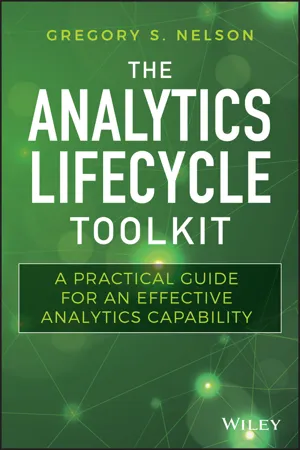
The Analytics Lifecycle Toolkit
A Practical Guide for an Effective Analytics Capability
- English
- ePUB (mobile friendly)
- Available on iOS & Android
The Analytics Lifecycle Toolkit
A Practical Guide for an Effective Analytics Capability
About this book
An evidence-based organizational framework for exceptional analytics team results
The Analytics Lifecycle Toolkit provides managers with a practical manual for integrating data management and analytic technologies into their organization. Author Gregory Nelson has encountered hundreds of unique perspectives on analytics optimization from across industries; over the years, successful strategies have proven to share certain practices, skillsets, expertise, and structural traits. In this book, he details the concepts, people and processes that contribute to exemplary results, and shares an organizational framework for analytics team functions and roles. By merging analytic culture with data and technology strategies, this framework creates understanding for analytics leaders and a toolbox for practitioners. Focused on team effectiveness and the design thinking surrounding product creation, the framework is illustrated by real-world case studies to show how effective analytics team leadership works on the ground.
Tools and templates include best practices for process improvement, workforce enablement, and leadership support, while guidance includes both conceptual discussion of the analytics life cycle and detailed process descriptions. Readers will be equipped to:
- Master fundamental concepts and practices of the analytics life cycle
- Understand the knowledge domains and best practices for each stage
- Delve into the details of analytical team processes and process optimization
- Utilize a robust toolkit designed to support analytic team effectiveness
The analytics life cycle includes a diverse set of considerations involving the people, processes, culture, data, and technology, and managers needing stellar analytics performance must understand their unique role in the process of winnowing the big picture down to meaningful action. The Analytics Lifecycle Toolkit provides expert perspective and much-needed insight to managers, while providing practitioners with a new set of tools for optimizing results.
Frequently asked questions
- Essential is ideal for learners and professionals who enjoy exploring a wide range of subjects. Access the Essential Library with 800,000+ trusted titles and best-sellers across business, personal growth, and the humanities. Includes unlimited reading time and Standard Read Aloud voice.
- Complete: Perfect for advanced learners and researchers needing full, unrestricted access. Unlock 1.4M+ books across hundreds of subjects, including academic and specialized titles. The Complete Plan also includes advanced features like Premium Read Aloud and Research Assistant.
Please note we cannot support devices running on iOS 13 and Android 7 or earlier. Learn more about using the app.
Information
PART I
The Foundation of Analytics
CHAPTER 1
Analytics Overview
…what enables the wise commander to strike and conquer, and achieve things beyond the reach of ordinary men, is foreknowledge. Now, this foreknowledge cannot be elicited from spirits…The Art of War, Sun Tzu (as seen in Giles, 1994)
FUNDAMENTAL CONCEPTS
Data
Analytics


What Is Analytics?
a comprehensive, data-driven strategy for problem solving
Inductive Reasoning
Table of contents
- Cover
- Title Page
- Table of Contents
- Preface
- Acknowledgments
- PART I: The Foundation of Analytics
- PART II: Analytics Lifecycle Best Practices
- PART III: Sustaining Analytics Success
- About the Author
- About the Companion Web Site
- Index
- End User License Agreement